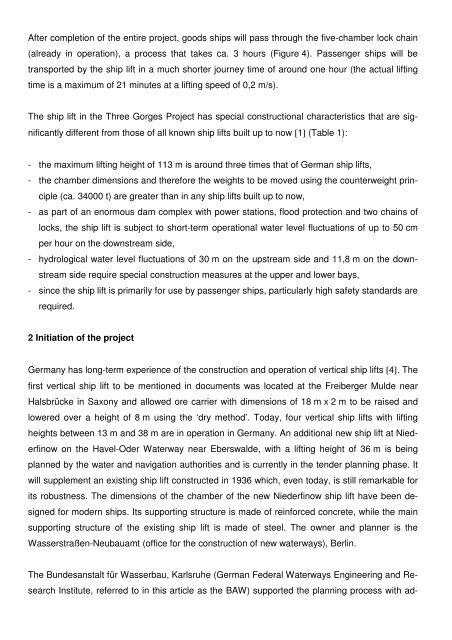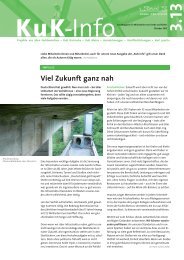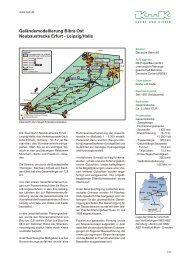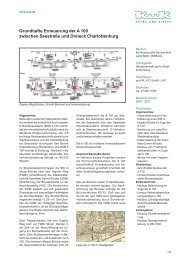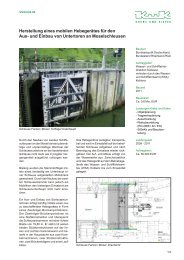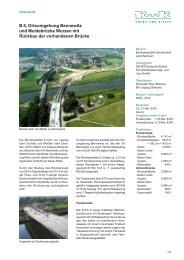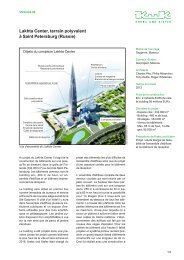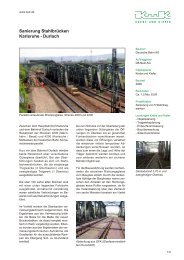Planning of the ship lift at the Three - Krebs und Kiefer, Beratende ...
Planning of the ship lift at the Three - Krebs und Kiefer, Beratende ...
Planning of the ship lift at the Three - Krebs und Kiefer, Beratende ...
Create successful ePaper yourself
Turn your PDF publications into a flip-book with our unique Google optimized e-Paper software.
After completion <strong>of</strong> <strong>the</strong> entire project, goods <strong>ship</strong>s will pass through <strong>the</strong> five-chamber lock chain<br />
(already in oper<strong>at</strong>ion), a process th<strong>at</strong> takes ca. 3 hours (Figure 4). Passenger <strong>ship</strong>s will be<br />
transported by <strong>the</strong> <strong>ship</strong> <strong>lift</strong> in a much shorter journey time <strong>of</strong> aro<strong>und</strong> one hour (<strong>the</strong> actual <strong>lift</strong>ing<br />
time is a maximum <strong>of</strong> 21 minutes <strong>at</strong> a <strong>lift</strong>ing speed <strong>of</strong> 0,2 m/s).<br />
The <strong>ship</strong> <strong>lift</strong> in <strong>the</strong> <strong>Three</strong> Gorges Project has special constructional characteristics th<strong>at</strong> are sig-<br />
nificantly different from those <strong>of</strong> all known <strong>ship</strong> <strong>lift</strong>s built up to now [1] (Table 1):<br />
- <strong>the</strong> maximum <strong>lift</strong>ing height <strong>of</strong> 113 m is aro<strong>und</strong> three times th<strong>at</strong> <strong>of</strong> German <strong>ship</strong> <strong>lift</strong>s,<br />
- <strong>the</strong> chamber dimensions and <strong>the</strong>refore <strong>the</strong> weights to be moved using <strong>the</strong> counterweight prin-<br />
ciple (ca. 34000 t) are gre<strong>at</strong>er than in any <strong>ship</strong> <strong>lift</strong>s built up to now,<br />
- as part <strong>of</strong> an enormous dam complex with power st<strong>at</strong>ions, flood protection and two chains <strong>of</strong><br />
locks, <strong>the</strong> <strong>ship</strong> <strong>lift</strong> is subject to short-term oper<strong>at</strong>ional w<strong>at</strong>er level fluctu<strong>at</strong>ions <strong>of</strong> up to 50 cm<br />
per hour on <strong>the</strong> downstream side,<br />
- hydrological w<strong>at</strong>er level fluctu<strong>at</strong>ions <strong>of</strong> 30 m on <strong>the</strong> upstream side and 11,8 m on <strong>the</strong> down-<br />
stream side require special construction measures <strong>at</strong> <strong>the</strong> upper and lower bays,<br />
- since <strong>the</strong> <strong>ship</strong> <strong>lift</strong> is primarily for use by passenger <strong>ship</strong>s, particularly high safety standards are<br />
required.<br />
2 Initi<strong>at</strong>ion <strong>of</strong> <strong>the</strong> project<br />
Germany has long-term experience <strong>of</strong> <strong>the</strong> construction and oper<strong>at</strong>ion <strong>of</strong> vertical <strong>ship</strong> <strong>lift</strong>s [4]. The<br />
first vertical <strong>ship</strong> <strong>lift</strong> to be mentioned in documents was loc<strong>at</strong>ed <strong>at</strong> <strong>the</strong> Freiberger Mulde near<br />
Halsbrücke in Saxony and allowed ore carrier with dimensions <strong>of</strong> 18 m x 2 m to be raised and<br />
lowered over a height <strong>of</strong> 8 m using <strong>the</strong> ‘dry method’. Today, four vertical <strong>ship</strong> <strong>lift</strong>s with <strong>lift</strong>ing<br />
heights between 13 m and 38 m are in oper<strong>at</strong>ion in Germany. An additional new <strong>ship</strong> <strong>lift</strong> <strong>at</strong> Nied-<br />
erfinow on <strong>the</strong> Havel-Oder W<strong>at</strong>erway near Eberswalde, with a <strong>lift</strong>ing height <strong>of</strong> 36 m is being<br />
planned by <strong>the</strong> w<strong>at</strong>er and navig<strong>at</strong>ion authorities and is currently in <strong>the</strong> tender planning phase. It<br />
will supplement an existing <strong>ship</strong> <strong>lift</strong> constructed in 1936 which, even today, is still remarkable for<br />
its robustness. The dimensions <strong>of</strong> <strong>the</strong> chamber <strong>of</strong> <strong>the</strong> new Niederfinow <strong>ship</strong> <strong>lift</strong> have been de-<br />
signed for modern <strong>ship</strong>s. Its supporting structure is made <strong>of</strong> reinforced concrete, while <strong>the</strong> main<br />
supporting structure <strong>of</strong> <strong>the</strong> existing <strong>ship</strong> <strong>lift</strong> is made <strong>of</strong> steel. The owner and planner is <strong>the</strong><br />
Wasserstraßen-Neubauamt (<strong>of</strong>fice for <strong>the</strong> construction <strong>of</strong> new w<strong>at</strong>erways), Berlin.<br />
The B<strong>und</strong>esanstalt für Wasserbau, Karlsruhe (German Federal W<strong>at</strong>erways Engineering and Re-<br />
search Institute, referred to in this article as <strong>the</strong> BAW) supported <strong>the</strong> planning process with ad-


